
Lavandula is a genus of 47 known species of flowering plants in the mint family, Lamiaceae. It is native to the Old World and is found in Cape Verde and the Canary Islands, and from Europe across to northern and eastern Africa, the Mediterranean, southwest Asia to India.
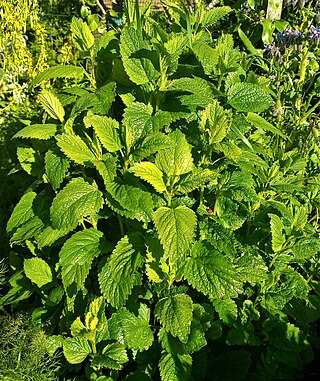
Lemon balm is a perennial herbaceous plant in the mint family and native to south-central Europe, the Mediterranean Basin, Iran, and Central Asia, but now naturalised elsewhere.
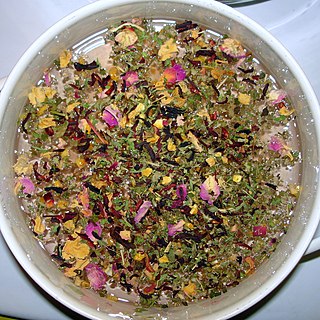
Herbal teas, also known as herbal infusions and less commonly called tisanes, are beverages made from the infusion or decoction of herbs, spices, or other plant material in hot water. Oftentimes herb tea, or the plain term tea, is used as a reference to all sorts of herbal teas. Many herbs are used in herbal medicine. Some herbal blends contain actual tea.

Tropaeolum, commonly known as nasturtium, is a genus of roughly 80 species of annual and perennial herbaceous flowering plants. It was named by Carl Linnaeus in his book Species Plantarum, and is the only genus in the family Tropaeolaceae. The nasturtiums received their common name because they produce an oil similar to that of watercress.

Geranium is a genus of 422 species of annual, biennial, and perennial plants that are commonly known as geraniums or cranesbills. They are found throughout the temperate regions of the world and the mountains of the tropics, with the greatest diversity in the eastern part of the Mediterranean region.

Boraginaceae, the borage or forget-me-notfamily, includes about 2,000 species of shrubs, trees, and herbs in 146 to 156 genera with a worldwide distribution.

Tilia is a genus of about 30 species of trees or bushes, native throughout most of the temperate Northern Hemisphere. The tree is known as linden for the European species, and basswood for North American species. In Britain and Ireland they are commonly called lime trees, although they are not related to the citrus lime. The genus occurs in Europe and eastern North America, but the greatest species diversity is found in Asia. In Chinese, "椴/duàn" or "椴樹/duànshù" is a general term for Tilia species. Under the Cronquist classification system, this genus was placed in the family Tiliaceae, but genetic research summarised by the Angiosperm Phylogeny Group has resulted in the incorporation of this genus, and of most of the previous family, into the Malvaceae.

Passiflora, known also as the passion flowers or passion vines, is a genus of about 550 species of flowering plants, the type genus of the family Passifloraceae.
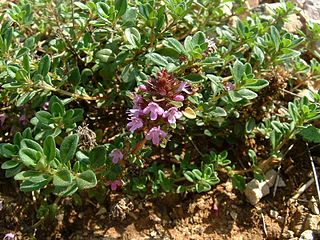
Thymus serpyllum, known by the common names of Breckland thyme, Breckland wild thyme, wild thyme, creeping thyme, or elfin thyme, is a species of flowering plant in the mint family Lamiaceae, native to most of Europe and North Africa. It is a low, usually prostrate subshrub growing to 2 cm (1 in) tall with creeping stems up to 10 cm (4 in) long. The oval evergreen leaves are 3–8 mm long. The strongly scented flowers are either lilac, pink-purple, magenta, or a rare white, all 4–6 mm long and produced in clusters. The hardy plant tolerates some pedestrian traffic and produces odors ranging from heavily herbal to lightly lemon, depending on the variety.

Passiflora incarnata, commonly known as maypop, purple passionflower, true passionflower, wild apricot, and wild passion vine, is a fast-growing perennial vine with climbing or trailing stems. A member of the passionflower genus Passiflora, the maypop has large, intricate flowers with prominent styles and stamens. One of the hardiest species of passionflower, it is both found as a wildflower in the southern United States and in cultivation for its fruit and striking bluish purple blooms.

Dianthus barbatus, the sweet William, is a species of flowering plant in the family Caryophyllaceae, native to southern Europe and parts of Asia. It has become a popular ornamental garden plant. It is a herbaceous biennial or short-lived perennial plant growing to 13–92 cm tall, with flowers in a dense cluster of up to 30 at the top of the stems. Each flower is 2–3 cm diameter with five petals displaying serrated edges. Wild plants produce red flowers with a white base, but colours in cultivars range from white, pink, red, and purple to variegated patterns. The exact origin of its English common name is unknown but first appears in 1596 in botanist John Gerard's garden catalogue. The flowers are edible and may have medicinal properties. Sweet William attracts bees, birds, and butterflies.
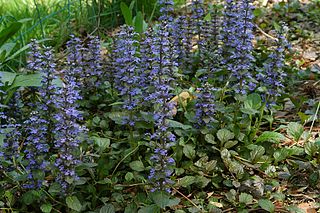
Ajuga reptans is commonly known as bugle, blue bugle, bugleherb, bugleweed, carpetweed, carpet bugleweed, and common bugle, and traditionally however less commonly as St. Lawrence plant. It is an herbaceous flowering plant in the mint family Lamiaceae, native to Europe. It is invasive in parts of North America. It is also a component of purple moor grass and rush pastures, a Biodiversity Action Plan habitat in the United Kingdom.

Pentaglottis is a monotypic genus of flowering plants in the family Boraginaceae. It is represented by a single species, Pentaglottis sempervirens, commonly known as the green alkanet, evergreen bugloss or alkanet, and is a bristly, perennial plant native to southwestern Europe, in northwest Iberia and France.

Malva sylvestris is a species of the mallow genus Malva in the family of Malvaceae and is considered to be the type species for the genus. Known as common mallow to English-speaking Europeans, it acquired the common names of cheeses, high mallow and tall mallow as it migrated from its native home in Western Europe, North Africa and Asia through the English-speaking world.
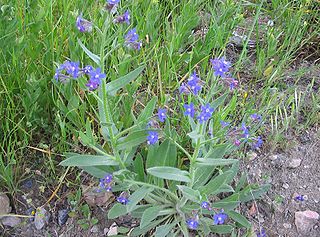
Anchusa azurea is a species of flowering plant in the family Boraginaceae, known by the common names garden anchusa and Italian bugloss. This bristly herbaceous perennial may reach 1.5 m (4.9 ft) tall and 60 cm (24 in) wide. It has straight lance-shaped leaves and petite tubular flowers about 15 millimeters across with five bright violet-blue petals. These flowers, which typically appear in May–July, are edible and attract bees. This species is native to Europe, western Asia, and eastern Maghreb.

Symphytum officinale is a perennial flowering plant in the family Boraginaceae. Along with thirty four other species of Symphytum, it is known as comfrey. To differentiate it from other members of the genus Symphytum, this species is known as common comfrey or true comfrey. Other English names include boneset, knitbone, consound, and slippery-root. It is native to Europe, growing in damp, grassy places. It is locally frequent throughout Ireland and Britain on river banks and ditches. It occurs elsewhere, including North America, as an introduced species and sometimes a weed. The flowers are mostly visited by bumblebees. Internal or long-term topical use of comfrey is discouraged due to its strong potential to cause liver toxicity.
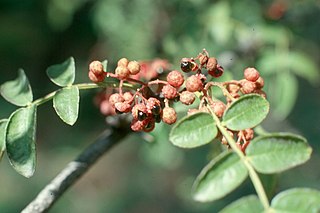
Zanthoxylum americanum, the common prickly-ash, common pricklyash, common prickly ash or northern prickly-ash, is an aromatic shrub or small tree native to central and eastern portions of the United States and Canada. It is the northernmost New World species in the citrus family, Rutaceae, and is the type species in its genus, which includes sichuan pepper. It can grow to 10 meters (33 ft) tall with a diameter at breast height (DBH) of 15 cm (5.9 in). It produces membranous leaflets and axillary flower clusters. The wood is not commercially valuable, but oil extracts from the bark have been used in traditional and alternative medicine, and have been studied for antifungal and cytotoxic properties. The genus name is sometimes spelled Xanthoxylum.

Ellisia is a genus of flowering plants in the forget-me-not family (Boraginaceae), containing the sole species Ellisia nyctelea. It is native to North America, where it is also known as Aunt Lucy, false baby blue eyes, and waterpod. The genus was named in honor of British naturalist John Ellis, a contemporary of, and correspondent to, Carl Linnaeus. It was published and described by Linnaeus, in his book Species Plantarum ed.2 on page 1662 in 1763.

Cerinthe major, called honeywort along with other members of its genus, is an annual species of flowering plant in the genus Cerinthe, native to the Mediterranean region, and introduced to New Zealand. Gardeners have a choice along a spectrum of cultivars ranging from Cerinthe major subsp. major, with sea-green bracts and yellow flowers, to Cerinthe major subsp. purpurascens with blue bracts and purple flowers.



















